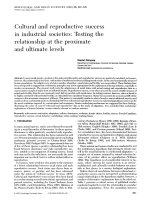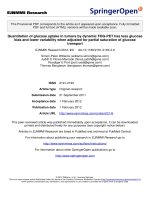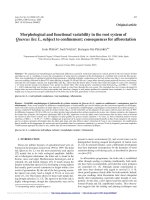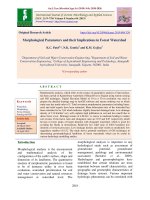Cultural and morphological variability in different colletotrichum Lagenarium isolates of bottle gourd in Haryana
Bạn đang xem bản rút gọn của tài liệu. Xem và tải ngay bản đầy đủ của tài liệu tại đây (396.69 KB, 8 trang )
Int.J.Curr.Microbiol.App.Sci (2019) 8(6): 420-427
International Journal of Current Microbiology and Applied Sciences
ISSN: 2319-7706 Volume 8 Number 06 (2019)
Journal homepage:
Original Research Article
/>
Cultural and Morphologically Variability in Different
Colletotrichum lagenarium Isolates of Bottle Gourd in Haryana
Ankit Kumar, Narender Singh*, Kushal Raj, R.S. Chauhan and Manoj Kumar
Department of Plant Pathology, CCS, Haryana Agricultural University, Hisar-125004, India
*Corresponding author
ABSTRACT
Keywords
Bottle gourd,
Variability,
Conidia,
Sporulation and
isolates
Article Info
Accepted:
04 May 2019
Available Online:
10 June 2019
Bottle gourd (Lagenaria siceraria) is one of the important cucurbitaceous vegetable crop
being grown both during warm and rainy season in northern parts of India. It has wide
genetic diversity and is grown throughout the tropics and subtropics of the world. Bottle
gourd is prone to various fungal bacterial and viral diseases. Among various fungal
diseases Anthracnose, Downy mildew and Cercospora leaf spot are widely prevalent in
different bottle gourd growing areas. Anthracnose caused by Colletotrichum lagenarium
(Pass.) Ellis. and Halsted is of major economic importance. Keeping in view the
importance of this disease in this region, the present investigation was carried out under
laboratory condition in the department of Plant Pathology during 2016 at CCS, HAU,
Hisar . In the variability studies, potato dextrose agar medium was found best medium for
growth of Colletotrichum lagenarium. The fungus grew well at 6.5 pH and 30ᵒC
temperature, whereas, minimum growth of fungus was observed on oat meal agar medium
at 7.5 pH and 35ᵒC temperature. Among various isolates Karnal (CL2) and Kaithal (CL3)
isolates were found fast growing. Least growth was observed in Yamuna nagar (CL5)
isolate. Maximum conidia size and sporulation was recorded in Karnal (CL2) isolate
grown on potato dextrose agar media at 35°C temperature and 6.5 pH.
Bottle gourd is prone to various fungal
bacterial and viral diseases. Among various
fungal diseases Anthracnose, Downy mildew
and Cercospora leaf spot are widely prevalent
in different bottle gourd growing areas.
Anthracnose caused by Colletotrichum
lagenarium (Pass.) Ellis. and Halsted is of
major economic importance. Anthracnose
disease was first reported by Gardner (1918)
from USA and by Mundkur (1937) from
India. Several species of plant pathogenic
fungi under the genus Colletotrichum cause
anthracnose in bottle gourd, other vegetables
Introduction
Bottle gourd (Lagenaria siceraria) is one of
the important cucurbitaceous vegetable crop
grown extensively throughout the world. The
origin of bottle gourd is assumed from Africa
and domestication occurred in tropical low
lands of south Central America. In India
bottle gourd is cultivated in an area of 103.23
thousand ha with productivity of 17.61 ton/ha
(Anonymous, 2016). In Haryana bottle gourd
is cultivated during summer and rainy season.
420
Int.J.Curr.Microbiol.App.Sci (2019) 8(6): 420-427
and fruits. Anthracnose of bottle gourd
regularly occurs in different bottle gourd
growing area during both the seasons. The
pathogen is seed borne in nature but initiation
as well as spread of disease largely depends
upon the environmental factors. This disease
is widespread under both greenhouse and
field cultivation resulting in poor fruit quality
and yield. Direct infection on the fruit also
results in loss of market value.
Colletotrichum
lagenarium
anthracnose of bottle gourd.
causing
Materials and Methods
The present studies on cultural and
morphologically variability of bottle gourd
anthracnose caused by Colletotrichum
lagenarium (Pass.) Ellis and Halsted was
carried out during 2016 in the laboratory
Department of Plant Pathology, College of
Agriculture, CCS Haryana Agricultural
University, Hisar. The details of the material
used and methodology adopted during the
course of this investigation are given below.
The symptoms appears as brownish specks,
which grows into angular and roughly circular
spots on the leaves, whereas on young fruits
numerous water soaked, depressed, oval or
circular spots are observed. Colletotrichum
lagenarium also cause premature plant death
by reducing the photosynthetic surface area to
the extent of 29–42%, resulting in yield losses
of 6–48%. The disease is reported to occur in
epiphytotic form in India (Madan and Grover,
1977) and Japan (Kobayshi et al., 1998).
Collection
of
samples,
isolation,
purification
and
maintenance
of
Colletotrichum lagenarium
The fruits and leaves of bottle gourd having
characteristic symptoms of anthracnose were
collected from different locations of Haryana.
These samples were subjected to isolation and
purification of the pathogen. Infected portions
of diseased leaves were cut into small pieces.
The cut pieces of infected portion were
surface sterilized with 0.1 per cent mercuric
chloride solution for 30 seconds followed by
3-4 washings in sterile distilled water. The cut
pieces were then aseptically transferred to
Petri dishes containing potato dextrose agar
(PDA) medium and inoculated at 28±1°C for
8 days. The single spore isolation was done to
purify the culture after 8 days of inoculation.
The test fungus was identified as
Colletotrichum lagenarium based on the
cultural and morphological characteristics
(Madan and Grover, 1977). The stock culture
of fungus was multiplied on PDA slants at
28±1°C and maintained by subculturing and
stored at 5±1°C. This stock culture was used
for future work. The different isolates
collected from different locations of Haryana
are summarized in Table 1.
Traditionally, Colletotrichum species have
been
identified
and
delimited
on
morphological characters. Several features
have been utilized by taxonomists including
size and shape of conidia and appressoria,
presence or absence of setae, sclerotia,
acervuli and teleomorph state and cultural
characters such as colony, growth rate and
texture (Photita et. al., 2005; Than et. al.,
2008a; Thaung, 2008). These criteria alone
are not always adequate for reliable
differentiation among Colletotrichum species
due to variation in morphology and phenotype
among
species
under
environmental
influence. Some taxa have uncertain or
extensive host relationship and pathological
variations and are often morphologically
variable in culture (Freeman et. al., 2000;
Latunde-Dada, 2001; Du et. al., 2005;
Thaung, 2008). By keeping its importance of
this disease in this region, the present study
has been taken up with the objectives to study
cultural and morphologically variability in
421
Int.J.Curr.Microbiol.App.Sci (2019) 8(6): 420-427
solidify. The Petri plates were inoculated with
5 mm mycelial disc obtained from 8-10 days
old culture of different isolates. The
inoculated Petri dishes were incubated at 25,
30 and 35°C temperature in BOD incubators
by maintaining four replications. The radial
growth in each case was determined by taking
average of the colony diameter in two
directions at regular interval of 48 h upto ten
days of inoculation.
Variability studies
Morphological variations
The Petri plates poured with Potato dextrose
agar and Oat meal agar medium with different
pH i.e. 6.5, 7.0 and 7.5 were inoculated with
seven days old 5 mm culture disc of different
isolates of Colletotrichum lagenarium and
incubated for ten days at 25, 30 and 35°C by
maintain four replications in completely
randomized block design. The morphological
characters viz., colony colour, size of conidia
and shape of conidia were examined.
Sporulation of isolates on different media
To study the extent of sporulation, four
mycelial bits (5 mm each) were taken with the
help of a cork borer from the periphery of
Petri plates cultures and mashed in 10 ml of
distilled water and shaked thoroughly. Drops
were taken from the suspension and the
number of conidia was counted with the help
of heamocytometer and sporulation was
expressed as number of conidia ml־¹ of
suspension.
Cultural variations
Growth of C. lagenarium on different
media
The
morphological
and
cultural
characteristics were examined on two medium
i.e. Potato dextrose agar and Oat meal agar
media sterilized at 15 lb pressure per square
inch for 20 minutes with pH of media was
adjusted at 6.5, 7.0 and 7.5 by adding 0.1N
NaOH or 0.1N HCL.
Results and Discussion
Cultural and morphological variability in
different Colletotrichum lagenarium isolates
The composition of Potato Dextrose Agar and
Oat meal Agar are given below:
C. lagenarium the incitant of bottlegourd
anthracnose isolates of five locations were
evaluated on PDA and OMA (pH 6.5, 7.0 and
7.5) at different temperature viz., 250C, 300C
and 350C.
Potato dextrose agar medium
Peeled potato extract
Dextrose
Agar agar
Distilled water
200 g
20.0 g
20.0 g
1000 ml
Mycelial growth of C. lagenarium isolate (s)
on Potato dextrose agar (PDA) and Oat
meal agar (OMA) at different temperature
(pH 6.5)
Oat meal agar medium
Oat-meal
Agar agar
Distilled water
40.0 g
20.0 g
1000 ml
C. lagenarium the incitant of bottle gourd
anthracnose isolates of five locations were
evaluated on PDA and OMA (pH 6.5) at
different temperature viz., 250C, 300C and
350C. The observations are computed in Table
2. It is evident from the results that the
Twenty five ml of medium was poured
aseptically in each Petri dish and allowed to
422
Int.J.Curr.Microbiol.App.Sci (2019) 8(6): 420-427
mycelial growth of each isolate was
maximum at 300C irrespective of the medium
used. Amongst different isolates of C.
lagenarium, the growth of designated isolate
as CL2 of Karnal location was maximum
irrespective of the medium used or incubated
at 250C, 300C and 350C. The growth of
Karnal isolate was better on PDA in
comparison to OMA medium.
pH 6.5 and pH 7.0. Amongst different isolates
of C. lagenarium, the growth of designated
isolate as CL2 of Karnal location was
maximum irrespective of the medium used or
incubated at 250C, 300C and 350C. The
growth of fast growing isolate of C.
lagenarium (CL2) of Karnal location was
superior on PDA medium (pH 6.5 at 300C).
The results of present are in positive
agreement with the findings of Vanan (2001)
reported that the optimum temperature for the
growth of Colletotrichum capsici was 30°C.
Similarly, Photita et. al., (2005) and Deyol
(2010) also reported 30°C as optimum
temperature for the growth of C. capsici.
Mycelial growth of C. lagenarium isolate(s)
on Potato dextrose agar (PDA) and Oat
meal agar (OMA) at different temperature
(pH 7.0)
C. lagenarium the incitant of bottle gourd
anthracnose isolates of five locations were
evaluated on PDA and OMA (pH 7.0) at
different temperature viz., 250C, 300C and
350C (Table 3). The mycelial growth of each
isolate was maximum at 300C irrespective of
the medium used (Table 4). However
mycelial growth of the each isolate
comparatively slow at pH 7.0. Amongst the
different isolates of C. lagenarium, the
designated isolate as CL2 of Karnal location
growth was maximum irrespective of the
medium used or incubated at 250C, 300C and
350C. The growth of Karnal isolate (CL2) was
superior on PDA in comparison to OMA
medium.
Conidial size and colony colour of different
isolates on different media
The size and shape of C. lagenarium isolate’s
conidia were examined after 10 days of
inoculation on PDA and OMA medium (pH
6.5) at 300C. The observations of conidial size
and colony colour are presented in Table 5.
The conidia size of Karnal isolate (CL2) was
maximum on both the medium i.e. PDA (1526×4.4-5.9) and OMA (15-26×4.8-5.7) in
comparison to other isolates. The conidial size
of different isolates was in corroborative to
that of the growth pattern of the isolates on
different medium as well as pH. The colony
colour of the different isolates at frequent
interval of the incubation remain variable
from white to that of light brownish tinch.
The colony colour of less sporulating isolate
of Yamuna nagar location was light brownish.
There was uniform conidia shape i.e ovoid
type irrespective of each isolate grown on
different medium. Davis et. al., (1992)
reported variability in conidial size within
isolates of C. gloeosporioides. Variation in
conidial size, sporulation and growth pattern
were observed among the isolates collected
from different locations (Zakaria, 2000). In
present investigation, all the isolates showed
Mycelial growth of C. lagenarium isolate (s)
on Potato dextrose agar (PDA) and Oat
meal agar (OMA) at different temperature
(pH 7.5)
C. lagenarium the incitant of bottle gourd
anthracnose isolates of five locations were
evaluated on PDA and OMA (pH 7.5) at
different temperature viz., 250C, 300C and
350C. It is evident from the Table 4 that the
mycelial growth of each isolate was
maximum at 300C irrespective of the medium
used. However, mycelial growth of the each
isolate was slow at pH 7.5 in comparison to
423
Int.J.Curr.Microbiol.App.Sci (2019) 8(6): 420-427
higher conidial production on PDA medium
as compared to OMA medium. However,
Lenne et. al., (1984) found that OMA was
superior to PDA for comparing and
distinguishing Colletotrichum in culture.
From the review of literature it is evident that
no such specific study has been carried out
indicating the distinction of spore size within
the isolates.
medium. The sporluation of Karnal isolate
(CL2) was maximum (74.86 x 10⁴) on PDA
medium in comparison to other isolates.
Palarpawar (1987) also found variation in
sporulation pattern of C. capsici and C.
curcumae on different media i.e. KNOз
glucose medium, Potato dextrose agar
medium, Dasgupta’s standard medium and
dextrose asparagines phosphate medium. In
present investigation it was found that
sporulation for all isolates was most abundant
on PDA. Jeyalakshmi and Seetharaman
(1999) also reported that maximum
sporulation of C. capsici occurred on PDA
followed by Czapek’s dox agar and Richard’s
agar. Christopher et. al., (2013) also reported
that different isolates of C. capsici showed
profuse sporulation on PDA medium.
Sporulation pattern of C. lagenarium on
different media (pH 6.5) at temperature
300C
The sporulation pattern of each isolate was
examined on different media at 300C and the
observations are computed in Table 6. It is
evident from the results that the sporluation
pattern was significantly superior on PDA
medium in comparison to that of OMA
Table.1 Isolate collected from different locations of Haryana
S. N.
Location
Host (variety/hybrid)
1
2
3
4
5
Kurukshetra
Karnal
Kaithal
Ambala
Yamuna nagar
Pusa Naveen
Pusa Meghdoot
GH-3
PSPL
Pusa Naveen
Colletotrichum lagenarium
isolate
CL1
CL2
CL3
CL4
CL5
Table.2 Mycelial growth of different isolates on different media and temperature at pH 6.5
Isolates
Media→
Temperature
→
Colletotrichum lagenarium (CL1)
Colletotrichum lagenarium (CL2)
Colletotrichum lagenarium (CL3)
Colletotrichum lagenarium (CL4)
Colletotrichum lagenarium (CL5)
C.D(p=0.05)
SE(m)
Mycelial growth (mm)
Potato dextrose agar
Oat meal agar
25ºC
30ºC
35ºC
25ºC
30ºC
35ºC
86.75
90.00
84.75
82.50
71.50
Media (M)
0.56
0.20
90.00
76.50
90.00
80.50
90.00
75.00
87.50
68.75
80.50
63.50
Temperature
(T)
0.686
0.244
424
80.50
84.50
76.75
72.50
65.50
Isolates
(I)
0.886
0.315
82.50
68.75
90.00
75.50
82.50
71.00
81.50
61.75
78.50
56.00
Interaction
(M X T X I)
2.169
0.772
Int.J.Curr.Microbiol.App.Sci (2019) 8(6): 420-427
Table.3 Mycelial growth of different isolates on different media and temperature at pH 7.0
Isolates
Media→
Mycelial growth (mm)
Potato dextrose agar
Oat meal agar
Temperature→
25ᵒC
30ᵒC
35ᵒC
25ᵒC
30ᵒC
35ᵒC
82.50
84.50
71.50
74.50
78.25
66.50
C. lagenarium (CL1)
90.00
90.00
74.50
82.50
85.50
72.50
C. lagenarium (CL2)
81.00
90.00
69.25
71.50
75.50
63.50
C. lagenarium (CL3)
77.50
80.50
66.50
72.50
76.50
56.50
C. lagenarium (CL4)
65.50
73.50
60.50
60.50
73.50
53.50
C. lagenarium (CL5)
Media (M)
Temperature (T)
Isolates (I)
Interaction (MxTxI)
C.D (p=0.05)
0.415
0.508
0.655
1.605
0.148
0.181
0.233
0.571
SE(m)
Table.4 Mycelial growth of different isolates on different media and temperature at pH 7.5
Isolates
Media→
Temperatu
re
C. lagenarium (CL1)
C. lagenarium (CL2)
C. lagenarium (CL3)
C. lagenarium (CL4)
C. lagenarium (CL5)
C.D (p=0.05)
SE(m)
Mycelial growth (mm)
Potato dextrose agar
Oat meal agar
25ºC
30ºC
35ºC
25ºC
30ºC
35ºC
76.50
83.50
74.25
68.75
59.00
Media (M)
0.457
0.163
79.75
66.00
85.00
70.50
79.00
61.50
71.50
57.25
69.50
51.25
Temperature (T)
0.560
0.199
68.50
73.25
61.50
78.50
79.50
66.50
66.50
68.50
58.50
63.00
66.50
51.25
55.75
63.50
45.25
Isolates (I) Interaction (M X T X I)
0.722
1.769
0.257
0.630
Table.5 Conidial size and colony colour of different isolates on different media (pH 6.5) at
temperature 300C
Isolates
C. lagenarium (CL1)
C. lagenarium (CL2)
C.lagenarium (CL3)
C. lagenarium (CL4)
C. lagenarium (CL5)
Conidia size (µm)
Potato dextrose agar
Oat meal agar
14-23×4.3-5.6*
14-24×4.4-5.4
(18.20×5.2)**
(16.62×4.68)
15-26×4.4-5.9
15-26×4.8-5.7
(23.40×5.65)
(20.28×5.21)
13-24×4.2-5.6
14-21×4.5-5.3
(21.52×5.34)
(18.20×4.79)
14-24×4.1-5.7
13-24×4.3-5.4
(20.85×5.14)
(16.42×4.88)
13-22×4.1-5.3
12-21×4.1-5.1
(17.34×4.86)
(14.78×4.48)
* Range of conidia size ** Average size of conidia
425
Colony colour
White
White
Yellowish
Pinkish white
Light Brownish
Int.J.Curr.Microbiol.App.Sci (2019) 8(6): 420-427
Table.6 Sporulation of different isolates of C. lagenarium on different media (pH 6.5) at
temperature 300C
Isolates
C. lagenarium (CL1)
C. lagenarium (CL2)
C. lagenarium (CL3)
C. lagenarium (CL4)
C. lagenarium (CL5)
Media→
Sporulation (10⁴)
Potato dextrose agar
Oat meal agar
59.07
43.83
74.86
58.36
62.16
47.16
57.71
46.75
41.53
29.79
From the present investigation, it was
concluded that cultural and morphological
variation among different isolates of C.
lagenarium selected from different locations
revealed that isolates differ in their growth
rate on different media, temperature and pH.
Karnal (CL2) isolate was recorded to having
maximum mycelial growth, conidia size and
sporulation on both the media, whereas these
morphological characters were observed least
in Yamuna nagar (CL5) isolate. PDA medium
was the superior media for fungal growth at
30ᵒC temperature with 6.5 pH.
Thesis,
Department
of
plant
pathology,
C.C.S.,
Haryana
Agrcultural University, Hisar, India,
61 pp.
Du. M., Schardl, C.L. and Vaillancourt, L.J.
(2005). Using mating type gene
sequences for improved phytogenetic
resolution of Colletotrichum species
complexes. Mycologiea 97: 641-658.
Freeman, S., Minz, D., Jurkevitch, E.,
Mayman, M., and Shabi, E., (2000).
Molecular analysis of Colletotrichum
species from almond and other fruits.
Phytopathology 90: 608-614.
Gardner, M.W., (1918). Anthracnose of
cucurbits. United State Department of
Agriculture Bulletin 727: 1-68.
Jeyalakashmi, C. and Seetharaman, K.L.
(1999). Studies on the variability of
isolates of Colletotrichum capsici
(Syd.) Butler and Bisby causing chilli
fruit rot. Crop Research 17: 94-99.
Kobayashi, Y., Kimishima, E. and Tokei, R.
(1998). Anthracnose of pumpkin
caused by Colletotrichum orbiculare
(Berk. And Mnt.) Arx intercepted in
important plant quarantine in Japan.
Research Bulletin of the Plant
Protection Service, Japan 34: 55-58.
Latunde-Dada, A.O. (2001). Colletotrichum:
Tales of forcible entry, stealth,
transient confinement and breakout.
Molecular Plant Pathology 2: 187198.
Lenne, J.M., Sonoda, R.M. and Parbery, D.G.
References
Anonymous, (2016). www.Indiastat.com.
Christopher, D.J., Raj, T.S. and Kumar,
R.S.R. (2013). Morphological and
molecular
variability
in
Colletotrichum
capsici
causing
anthracnose of chilli in Tamilnadu.
Plant disease research 28(2): 121-127.
Davis, R.D., Boland, R.M. & Howitt, C.J.
(1992). Colony descriptions, conidium
morphology, and the effect of
temperature on colony growth of
Colletotrichum
gloeosporioides
isolated from Stylosanthes spp.
growing
in
several
countries.
Mycological Research 96: 128-134.
Deyol,
A.
(2010).
Variability
and
management of Colletotrichum capsici
(Syd.) Butler and Bisby, the incitant of
fruit rot of chilli (Capsicum annum).
426
Int.J.Curr.Microbiol.App.Sci (2019) 8(6): 420-427
(1984). Production of conidia by setae
of Colletotrichum species. Mycologia
76:359-362.
Madan, R.L. and Grover, R.K. (1977). Some
pathological studies on anthracnose
affecting
bottlegourd.
Indian
Phytopathology 30 : 392-398.
Madan, R.L. and Grover, R.K. (1977). Some
pathological studies on anthracnose
affecting
bottlegourd.
Indian
Phytopathology 30: 392-398.
Mundkur, B.B. (1937). Anthracnose of
cucurbits in Punjab. Current Science
12: 647.
Palarpawar, M.Y. (1987). Growth and
sporulation of Colletotrichum capsici
and Colletotrichum curcumae on
different culture media. Indian
Journal of Mycology and Plant
Pathology 17: 208.
Photita, W., Taylor, P.W.J., Ford, R.,
Lumyong, P., McKenzie, M.C. and
Hyde, K.D. (2005). Morphological
and molecular characterization of
Colletotrichum
species
from
herbaceous plants in Thailand. Fungal
Diversity 10: 117-133.
Than, P.P., Jeewon, R., Hyde, K.D.,
Pongsupasamit, S., Mongkolporn, O.
and
Taylor,
P.W.J.
(2008a).
Characterization and Pathogenicity of
Colletotrichum species associated with
anthracnose on chilli (Capsicum spp.)
in Thailand. Plant Pathology, 57: 562572.
Thaung,
M.M.
(2008).
Coelomycete
systematic with special reference to
Colletotrichum. Mycoscience 49: 345350.
Vanan, T. (2001). Studies on the variability in
Colletotrichum capsici (Syd.) Butler
and Bisby, the incitant of fruit rot of
chillies (Capsicum annum). M.Sc.
(Plant Pathology) Thesis, Deptt. of
Plant Pathology, CCS Haryana
Agricultural University, Hisar, India.
pp 69.
Zakaria, M. (2000). Morphology and cultural
variation
among
colletotrichum
isolates obtained from tropical forest
nurseries. Journal of Tropical Forest
Science 12(1): 1-20.
How to cite this article:
Ankit Kumar, Narender Singh, Kushal Raj, R.S. Chauhan and Manoj Kumar. 2019. Cultural
and Morphologically Variability in Different Colletotrichum lagenarium Isolates of Bottle
Gourd in Haryana. Int.J.Curr.Microbiol.App.Sci. 8(06): 420-427.
doi: />
427









